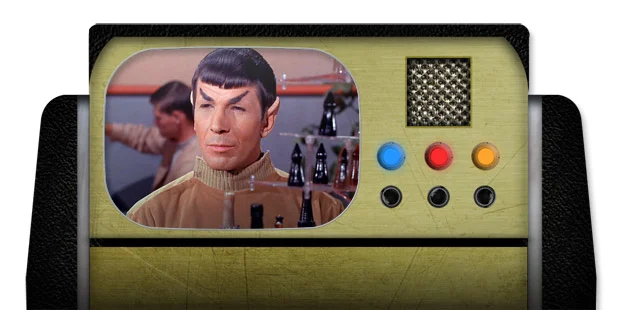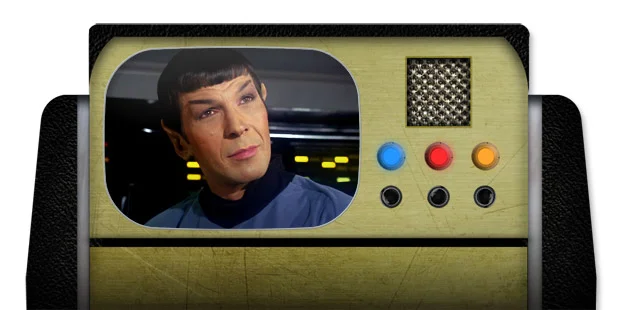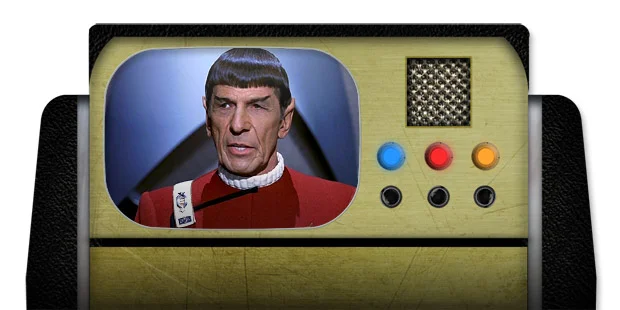by Lisa M. Lynch
If Vulcan has a cucumber equivalent, Mr. Spock would be as cool as that. With his slightly-upturned eyebrows just right for lifting in wry fascination at the absurdity of human behavior to his understated utterance of “fascinating” often targeting same, Mr. Spock is one calm, collected and unfazed alien.
But imagine an excitable, bushy-browed Mr. Spock. One who raises his voice on the bridge of the Enterprise. One who grins more than the captain. One who freely admits to “feeling.” Imagine a Mr. Spock who sports a fiery skin tone that belies a slightly murderous nature.
Wait. Are we talking about the same guy, here?
The first few episodes of Star Trek gave us an almost unrecognizable Spock. It was clear that, for awhile, nobody really knew what a Vulcan was. Not even the man portraying him.
Gene Roddenberry initially envisioned Mr. Spock as a devilish-looking alien - his ears tapered, his eyebrows raised high and severe. Even his skin was to simmer red. All he was missing was the forked tail! But screen tests determined that red-painted skin translated poorly on black and white television—Mr. Spock’s skin tone took on a jet black color—so they couldn’t use the hue they had in mind.
If red wouldn’t work, green was an acceptable alternative. Makeup artist Fred Philips, who had designed Spock’s ears, suggested Max Factor’s “Chinese Yellow” for that healthy greenish glow. It looked acceptably alien on color television and took on a neutral color for black and white screens.
So Spock got his color-adjustment, but he still had a ways to go.
Mr. Spock debuts in “The Cage”
The very first words spoken in Star Trek are those of Mr. Spock in the unaired series pilot, “The Cage.” As the viewer is guided onto the bridge of the Enterprise, a brisk and important first officer takes his place next to Captain Pike, announcing, “Check the circuit!” It is not immediately obvious that something is different about this man until we’re treated to a close-up. Then we see a pair of bushy upturned eyebrows and some crazy pointed ears!
Mr. Spock’s alien nature is physically clear, but he doesn’t have other qualities to define him as Vulcan.
One of the most telling moments of his incomplete state comes when he and the rest of the Enterprise’s landing party arrive on the planet Talos IV. Spock and Captain Pike encounter a curious singing plant with vibrating blue leaves. They investigate it and then glance at each other. Pike smiles a little, but Spock breaks out into a gleeful, toothy grin.
In “The Cage,” Jeffery Hunter’s Captain Pike is such a quiet, almost grim presence, that Mr. Spock seems excitable by comparison. He certainly has no air of superiority, no particular sign of a greater intelligence. He is not the lonely outsider, nor a bemused observer of the human condition. He is alien wall dressing; a token character to add some weirdness to life aboard a futuristic starship.
Where No Spock has Gone Since
Star Trek’s second pilot, “Where No Man has Gone Before” begins with Captain Kirk and Mr. Spock playing a game of three-dimensional chess, both wearing the same sickly-yellow tunics. Spock’s eyebrows are again bushy, but they seem even more arched than before, creating a “V” shape on his forehead. His hair is a little more grown out and his bangs are cut unevenly, just like Spock himself.
Spock’s healthy sense of superiority and disdain for emotion are on display for the first time. In response to Captain Kirk’s taunt about feeling irritation over possibly losing the game, he says, “Irritation? Ah, yes. One of your Earth emotions.”
Another hint of our Spock-to-be: During their conversation he mentions one of his ancestors married a human. Perhaps technically, his father is an ancestor.
But once Mr. Spock is on the bridge, he goes into what Leonard Nimoy describes in his book I am Spock as “first officer mode.” He yells orders and information to anyone who will listen. “Sensor beam on!” “It must be a force field of some kind!” “Damage control reports, all stations!” In fact, he yells more than the humans on the bridge.
At least Spock doesn’t smile to the extent he did in the first pilot, although he does quite a lot of smirking. But the Spock we know goes completely astray when the famously pacifist alien recommends killing Gary Mitchell, a crew member and friend of Jim Kirk’s who accidentally acquires dangerous psionic abilities.
Spock also seems especially fond of an impressive phaser rifle he carries around in a couple of scenes as he struggles to control an apparent trigger finger.
Another jarring un-Spock moment: At the end of the episode Jim Kirk laments Gary Mitchell’s fate since he did not choose to become evil. Spock responds, “I felt for him, too.” As one who keeps his emotions well-guarded, Spock would never admit to something like that so casually, especially on the bridge of all places!
The Corbomite Maneuver—A Fascinating Development
But here comes “The Corbomite Maneuver,” the next episode in production order. Mr. Spock is taking shape. His eyebrows have been tamed into a more muted upsweep and they are far better groomed. He is back in a science officer-blue tunic, although his collar is larger, giving him a sloppier appearance. The rest of the crew suffers from the larger collars as well.
He does have a more Zen-like presence during this episode, but he is still prone to hollering on the bridge. His face is also somewhat shiny, and his cheeks are pink with rouge suggesting he is warm and even prone to perspiring under pressure.
According to Nimoy in I am Spock, his first real insight into the character came from one simple word, spoken on the bridge in response to a particularly persistent alien vessel. Nimoy wasn’t sure how to have Spock say it. Although still in first officer mode, yelling it didn’t seem quite right. The episode’s director Joe Sargent suggested to him “…when you deliver your line, be cool and curious, a scientist.” Nimoy finally understood who Mr. Spock was. He uttered that one word:
“Fascinating.”
A Less Muddied Mr. Spock
In the next episode produced, “Mudd’s Women,” Spock is almost completely formed. Though he does sport slightly unkempt bangs, rouged cheeks, and the too-large collar on his tunic, he is much more quiet, contemplative, and intelligent. He is mentally the Mr. Spock we know and love, if not quite physically. He certainly does not share the rest of the male crews’ infatuation with Harry Mudd’s beautiful women. His almost imperceptible muttering of “curious” is pure Spock as he observes Scotty and Dr. McCoy’s hypnotic rapture at the ladies in the transporter room.
There are still a few more issues to be ironed out. Spock remains prone to smirking. Also, while examining a damaged lithium crystal, he observes, “Even burned and cracked, they’re beautiful.” Unless under the influence of spores or severe backwards time travel, Spock is not one to comment on the beauty of anything.
At the end of the episode, Mr. Spock declares that he is “Happy the affair is over.” Happy?
Fine-Tuning the Vulcan
By the next episode in production, “The Enemy Within,” we have our Spock. He has a more streamlined tunic to go with his more streamlined personality. Thanks to makeup artist Fred Phillips’ refining touch, his bangs are cut perfectly and his face is a cool, dry off-green. Our Mr. Spock will never sweat under pressure. Also, not even a hint of reddened cheeks, which were counterintuitive for a being composed of green blood.
And, as the pacifist we know him to be, Mr. Spock elects to use the more humane Vulcan nerve pinch to subdue Evil Kirk as opposed to punching him across the face.
Later episodes add to the character of Mr. Spock and the whole Vulcan legend. “The Naked Time” introduces the two sides of Mr. Spock: his human side and his Vulcan side. A powerful example of how these sides war with each other is on display when he is infected with a disease that causes him to lose his usual control. He hides in a room and sobs while insisting to himself that he is an officer and a Vulcan.
On a normal day, Mr. Spock can usually keep his human side under wraps, but it’s always there, we are to learn, and it haunts him.
“Dagger of the Mind” introduces Spock’s first mind-meld. Here it is a more intensive and dangerous process than portrayed in future episodes, but it does cement his role as a telepathic being.
In Season Two’s “Amok Time,” Spock must travel back to Vulcan to take a mate. During the wedding ceremony we see the very first Vulcan salute and hear the first mention of the iconic phrase “Live long and prosper.” Of course, Spock does not marry after all and believes to his horror that he has killed Captain Kirk during a ritualistic fight. When he learns of Kirk’s survival, he grabs the captain by the arms and breaks into an even more genuine smile than the one we saw in “The Cage.” But this smile is pure accident; a result of Spock’s great relief. He quickly disowns it after recovering himself.
Mr. Spock evolved again during the Star Trek films of the 1980s and 90s, but his character and all Vulcan mythology was really set down over the course of the original television series with a few key episodes. He experienced growing pains, arguably more so than any other character in Trek. But such a thing of complexity must start from the ground up.
Like Star Trek itself, Mr. Spock began jaggedly, only to be refined into that cool cucumber from Vulcan that the crew of the Enterprise, and all the rest of us, could count on.







